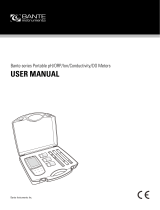
to indicate a certain setpoint or minimum concentration or trend. The
Ultrameter gives the user the capability to take data in “KCl conductivity
units” to compare to older published data, in terms of NaCl or 442, or as
may be appropriate. The Ultrameter can be used to reconcile data taken
with other compensation assumptions, especially with its ability to allow
custom characteristics through the USER mode.
XV. CONDUCTIVITY CONVERSION to TOTAL
DISSOLVED SOLIDS (TDS)
Electrical conductivity indicates solution concentration and ionization of
the dissolved material. Since temperature greatly affects ionization,
conductivity measurements are temperature dependent and are normally
corrected to read what they would be at 25°C (ref. Temperature
Compensation, pg. 29).
A. How it’s Done
Once the effect of temperature is removed, the compensated
conductivity is a function of the concentration (TDS). Temperature
compensation of the conductivity of a solution is performed automatically
by the internal processor, using data derived from chemical tables. Any
dissolved salt at a known temperature has a known ratio of conductivity to
concentration. Tables of conversion ratios referenced to 25°C have been
published by chemists for decades.
B. Solution Characteristics
Real world applications have to measure a wide range of materials and
mixtures of electrolyte solutions. To solve this problem, industrial users
commonly use the characteristics of a standard material as a model for
their solution, like the KCl favored by chemists for its stability.
Users dealing with sea water, etc., use NaCl as the model for their
concentration calculations. Users dealing with freshwater work with
mixtures including sulfates, carbonates and chlorides, the three
predominant components (anions) in freshwater that the Myron L
Company calls “natural water”. These are modeled in a mixture called
“442” which the Myron L Company markets for use as a calibration
standard, as it does standard KCl and NaCl solutions.
The Ultrameter contains internal algorithms for these 3 most commonly
referenced compounds. In the LCD display, the solution type being used
is shown on the left. Besides KCl, NaCl, and 442, there is the “USER”
choice. The benefit of USER is that one may enter the temperature
compensation and TDS ratio by hand, greatly increasing accuracy of
readings for a specific solution. That value remains a constant for all
32
measurements, and should be reset for different dilutions or
temperatures.
C. When does it make a lot of difference?
First, the accuracy of temperature compensation to 25°C determines the
accuracy of any TDS conversion. Assume we have industrial process
water to be pretreated by R.O. Assume it is 45°C and reads 1500 µS
uncompensated.
1. If NaCl compensation is used, an instrument would report 1035
µS compensated, which corresponds to 510 ppm NaCl.
2. If 442 compensation is used, an instrument would report 1024
µS compensated, which corresponds to 713 ppm 442.
The difference in values is 40%.
In spite of such large error, some users will continue to take data in the
NaCl mode because their previous data gathering and process
monitoring was done with an older NaCl referenced device.
Those who want true TDS readings that will correspond to evaporated
weight will select the correct Solution Type. If none of the 3 standard
solutions apply, the User mode must be used. Temperature
Compensation (Tempco) and TDS Derivation below, details the USER
mode.
XVI. TEMPERATURE COMPENSATION (Tempco)
and TDS DERIVATION
The Ultrameter contains internal algorithms for characteristics of the 3
most commonly referenced compounds. In the display, the solution type
being used is shown on the left. Besides KCl, NaCl, and 442, there is the
“USER” choice. The benefit of USER mode is that one may enter the
tempco and TDS conversion values of a unique solution from the
keyboard.
A. Conductivity Characteristics
When making conductivity measurements, the Solution Selection
determines the characteristic assumed as the instrument reports what a
measured conductivity would be if it were at 25°C. The characteristic is
represented by the tempco, expressed in %/°C. If a solution of 100 µS at
25°C increases to 122 µS at 35°C, then a 22% increase has happened
over this change of 10°C. The solution is said to have a tempco of 2.2
%/°C. 33






















